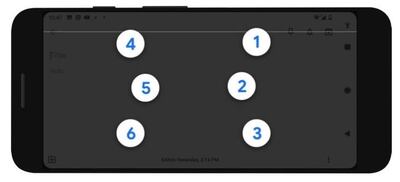How would you use your smartphone if your vision was impaired? Most of us have never had to consider this question, but, according to the World Heath Organisation, for an estimated 285 million people (more than the entire population of Indonesia) it's a daily concern. With modern life pivoting around the use of electronic devices, accessibility for the visually impaired is a growing issue. A step forward came last week, when Google unveiled an on-screen Braille keyboard for Android.
“We hope this keyboard can broadly expand Braille literacy and exposure among blind and low vision people,” said the tech company.
Recent improvements in voice computing have been hugely significant for the visually impaired. Voice recognition allows devices to be operated using the spoken word, while voice synthesis can describe the contents of a screen. But both technologies are far from perfect. The frustration that abled people feel when voice recognition goes awry is felt even more acutely by those visually impaired because they have fewer options to fall back on.
So, when Apple introduced an on-screen Braille keyboard to the iPhone and iPad back in 2014, many who would reap the benefits were ecstatic. “I do not exaggerate when I say this feature was life-changing,” wrote Alex Hall in an article for the website AppleVis, which publishes information for visually impaired people who use Apple products. “My phone has become my primary computing device, and Braille screen input is largely why.”
Google is introducing this convenience to about two billion Android devices, but according to Lee Huffman, editor of AccessWorld – a monthly publication about information technology and visual impairment – it will not be life-changing for everyone.
“Only 10 per cent of people who are blind and visually impaired use Braille on a regular basis,” he says. “It used to be that Braille was all there was, but usage has decreased because of speech technologies. For example, people who age into vision loss will usually not learn it.”
Google’s promotion of Braille could almost be seen as an industry-wide admission that alternative input methods are not always up to the job – particularly for tasks such as inputting complex passwords. In places where people are required to be quiet and voice dictation is impossible, this method may be the only option for people unfamiliar with Braille.
Apple’s early commitment to accessibility has made its devices an automatic choice for the blind and low vision people. But Apple products come at a cost, and this is a problem at the heart of accessibility: the best solutions are often the most expensive. “On Windows PCs, Microsoft’s built-in screen reader and magnifier are better than they used to be, but they are not as fully-fledged as something a specialist access technology company would produce,” says Luffman.
It’s easy to see how technological advances could leave the visually impaired behind. For example, users of screen readers know only too well how websites without tags to describe images are as good as useless. Google Chrome introduced a feature last October that uses artificial intelligence to describe said images (“appears to be a panda”) but this is still a best-guess fix to compensate for lazy web design.
Luffman believes the coronavirus crisis is putting a spotlight on many accessibility issues as people move to new ways of working.
“A platform like Zoom is accessible, but the deeper you get into the software – say, hosting a meeting and only allowing certain people in – the less accessible it gets,” he says. “The biggest challenge going forward is to ensure that developers of new technologies have accessibility in mind from the beginning.”
There is plenty of innovation under way. Google Maps recently introduced detailed voice guidance for the partially sighted. A new Microsoft app, Seeing AI, is a “talking camera” that can help the visually impaired read documents. Ford has unveiled a Braille device for car windows, to give information about the road.
Refreshable Braille displays, which convert web pages and images to patterns of dots, look set to become cheaper and more useful. “These are all things that can be added to our toolbox,” says Luffman. “Having these options will help people optimise what they do.” The introduction of Braille to Android might seem niche, but it could open up a world of technological power for millions of partially sighted people.


